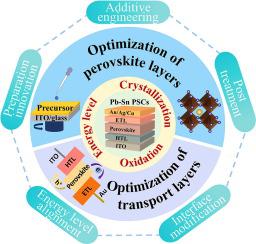Journal of Energy Chemistry ( IF 14.0 ) Pub Date : 2022-07-08 , DOI: 10.1016/j.jechem.2022.07.003
Yanyu Deng , Guanhua Ren , Danao Han , Wenbin Han , Zhuowei Li , Chunyu Liu , Wenbin Guo

|
Organic-inorganic hybrid lead-tin perovskite solar cells (Pb–Sn PSCs) have attracted much attention because of their advantages of low toxicity, variable bandgap, and feasibility for all-perovskite tandem solar cells, and the current power conversion efficiency (PCE) has exceeded 23%. However, due to the rambunctious crystallization process, easily oxidized Sn(Ⅱ) and inadequate energy level arrangement, there are many defects in perovskite films resulting in serious carrier recombination, which makes PCE still lag Pb-based PSCs. The quality of perovskite films is an important factor affecting the overall device performance. The selection and optimization of transport layers not only determines the interface energy level arrangement but also affects the carrier transport. In this paper, the research progress in improving performance of Pb–Sn PSCs in recent years is reviewed from aspects of perovskite layer and transport layers. The profound understanding of different promotion methods is summarized as well. These results have certain guiding significance for the future development and commercial application of Pb–Sn PSCs.
中文翻译:

Pb-Sn混合钙钛矿太阳能电池的最新进展
有机-无机杂化铅锡钙钛矿太阳能电池(Pb-Sn PSCs)因其毒性低、带隙可变、全钙钛矿串联太阳能电池的可行性以及当前的功率转换效率( PCE)等优点而备受关注。已超过 23%。然而,由于结晶过程杂乱无章,Sn(Ⅱ)易被氧化,能级排列不充分,钙钛矿薄膜存在诸多缺陷,导致载流子复合严重,使得PCE仍然落后于基于 Pb 的 PSC。钙钛矿薄膜的质量是影响器件整体性能的重要因素。传输层的选择和优化不仅决定了界面能级排列,而且影响着载流子的传输。本文从钙钛矿层和传输层两个方面综述了近年来在提高 Pb-Sn PSCs 性能方面的研究进展。对不同推广方式的深刻理解也进行了总结。这些结果对未来Pb-Sn PSCs的开发和商业应用具有一定的指导意义。

































 京公网安备 11010802027423号
京公网安备 11010802027423号